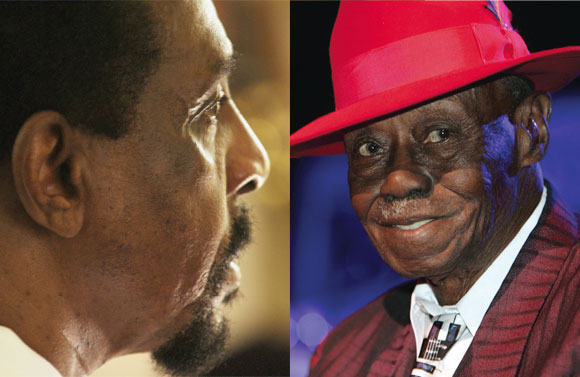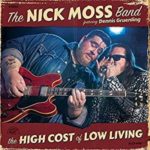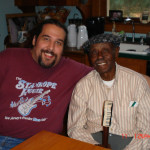
IKE TURNER
Despite being best remembered for his partnership and tumultuous marriage to Tina Turner, Izear Luster (“Ike”) Turner, Jr. has been a rock ‘n’ roll legend for more than five decades. This Rock and Roll Hall of Famer set the standard for the genre to emerge in the early 1950s, penning 1951’s “Rocket 88,” with his band, the Kings of Rhythm (despite its being credited to Jackie Brenston and his Delta Cats).
Born in 1931 in Clarksdale, Mississippi, Turner’s first foray into music occurred as a youngster, hanging out at radio station WROX where he would become a disc jockey by 1945. Turner became fully immersed in the boogie-woogie piano stylings of Pinetop Perkins, Ike’s mentor and piano teacher. By the mid-1950s, Turner switched to electric guitar, becoming one of the very first to pioneer whammy bar and distortion techniques.
At Sun Records, Ike became musician, talent scout, and producer, working with some of the biggest blues performers at the time, including BB King and Elmore James. Turner was the original A&R guy, unearthing tremendous local artists for many labels. Ike’s scouting talent was such that he sold Howlin’ Wolf to both Chess and Specialty. (Eventually Wolf went to Chess and Specialty got Rosco Gordon.)
Turner’s biggest break, however, came in 1956 when he and his Kings of Rhythm moved to St. Louis and met up with 16-year-old Anna Mae Bullock. With the Ike & Tina Turner Revue, Turner became a bona fide superstar, scoring countless chart hits with “A Fool In Love,” “It’s Gonna Work Out Fine,” and the duo’s biggest seller, “Proud Mary.”
After his marriage ended in divorce, Turner re-formed the Kings of Rhythm in the 1990s, (unfortunately, he missed his and Tina’s induction ceremony into the Hall of Fame while imprisoned in 1991), and issued his autobiography, Takin’ Back My Name, in 1999. In 2001, he released the Grammynominated album Here And Now (Ikon), which went on to win the W.C. Handy award for “Comeback Album of the Year.” More recently, Turner performed on the alternative band Gorillaz’ 2005 double platinum album Demon Days. His latest release is Risin’ with the Blues on Zoho Music.
PINETOP PERKINS
After over seven decades of playing the blues, there is no stopping the fingers of pianist Pinetop Perkins. Born Willie Perkins in Belzoni, MS, in 1913 (and dubbed Joe Willie since the family dog was also named Willie), he is one of the last remaining Mississippi bluesmen still performing from that legendary era. Best known for his work as a member of Muddy Waters’ band, he replaced Otis Spann in 1969 and stayed with Waters for 12 years.
The 93-year-old Perkins began his musical career playing locally as a guitarist; however, injuries from a stabbing in the mid-1940s forced him to change instruments. Luckily, he was guided by boogie-woogie pianist Clarence “Pinetop” Smith. In the early ‘40s he quit slide guitarist Robert Nighthawk’s KFFA radio show for rival Sonny Boy Williamson’s King Biscuit Times program in Helena, Arkansas. But his ties with his old gig still remained; in 1950, Perkins and Nighthawk collaborated for the Chess brothers on “Jackson Town Gal.”
One of Perkins’ best-known recordings, “Pinetop’s Boogie Woogie,” was recorded with Nighthawk disciple Earl Hooker during a quick stop at Sam Phillips’ famous Sun Studio in Memphis while on tour together in 1953. He then settled in Chicago and slowly drifted away from music until Hooker convinced him to get back into the game by playing on an LP for Arhoolie Records in 1968.
After playing with Muddy Waters’ band, Perkins and many of his bandmates/fellow bluesmen Louis Myers, Calvin Jones, Jerry Portnoy, and Willie “Big Eyes” Smith formed the Legendary Blues Band, recording numerous albums like Life of Ease and Red Hot ‘n’ Blue, until the early ‘90s. The dissolution of the band offered Perkins the opportunity to take off on his solo career. His most recent album release was last year’s On Top.
Catch this living legend as he tours into December. And if you want to experience blues tradition firsthand, make the trip to Clarksdale, Mississippi for Pinetop Perkins’ annual homecoming celebration. This year it was held on October 8th and featured Willie “Big Eyes” Smith and his band, Bob Margolin, Little Red Clay Swofford and special guests the Paul DeLay Band. It’s a great way to honor a true bluesman down near “The Crossroads,” where it all started. E
![]()
Elmore: What are you listening to right now?
Ike Turner: I’m not listening to anything right now. I get confused when I start recording, and I listen to too much other stuff, and I be thinkin’ I’m creating something and it’s something I heard.
Pinetop Perkins: The Blues Channel on cable, and the blues show on KUT in Austin. We called them up because they weren’t playing enough Pinetop. (Pinetop goes to clubs almost every night.)
EM: What was the first record you ever bought?
Ike: Charles Brown–no, you’re taking me back 60 or 65 years. That would have to be Louis Jordan, “Caldonia.”
PP: Muddy Waters. I don’t care so much for rock blues.
EM: Where do you buy your music?
Ike: I don’t buy anything.
PP: Any of them that have some good stuff.
EM: What’s your favorite album of all time?
Ike: I have two. The Who Who Are You and the Beach Boys “Good Vibrations.” And “What’d I Say,” Ray Charles. I’m really into country music a lot. I was born in Mississippi. I play country at my shows. You come to see my show, and we do 20-something songs, maybe three and a half minutes. I may start with boogie-woogie, or blues.
PP: Live at 85! with George Kilby, Jr.
EM: What was the first instrument you played?
Ike: Piano. I was taught by Pinetop Perkins. I love him to death.
PP: Guitar, then bass.
EM: What brought you to the instrument you now play?
Ike: I picked up guitar somewhere in the 50s. It was hard to find guitar players and when I got one, and I’d teach him from piano what I want him to play, and by the time he’d learn to play it, he’d get good, and sounding better, and he’d leave. I met a girl who played piano, church piano, and I taught her to play the blues, and I took up guitar.
PP: I started playing piano at about 12 or 13. I couldn’t chord the guitar after she stabbed me. My hand was hanging down, and my arm was too short when it healed up. Yeah, I used to teach Ike Turner piano, I liked it. He’s been good to me.
EM: What musician influenced you most?
Ike: Louis Jordan.
PP: I like all them good musicians, I like them playing good. I like boogie-woogie. There weren’t people teaching me, I learned it off records, Pinetop Smith, I loved what he did. I’ve played with so many different ones, I just forget the names.
EM: Who would you like to write with that you haven’t?
Ike: Babyface
PP: I don’t write. I got as high as third grade in school.
EM: What was the song or event that made you realize you wanted to be in music?
Ike: I was coming home from school and I heard this band. It was Pinetop and Sonny Boy Williamson. I had never noticed the piano in church or nothin’ before, and they were rehearsing at Ernest Lane’s father’s house. I heard all this noise comin’ out of this house, and I looked in through the window. I went home and said “Mama, I want a piano.” She said “If you bring me good grades in school.” And when I came home to show her my report card, she already had it. Taking lessons from a teacher was too slow for me, A.B.C.D.E, but Pinetop would show me boop-a-doop, boogie-woogie. Mama would ask what I learned from the teacher and I’d go boop-adoopa, and she’d say “Listen to my son!”
PP: I realized when I was real young, comin’ up.
EM: Who would you like in your rock and roll heaven band?
Ike: I like Elton John, and the Stones. Seth Blumberg on guitar, Armando Cepeda on bass, on keyboard, I want Paul Smith and Ernest Lane, because that’s who I have. Drums, Alan Krigger, Mike Johnson on horn.
PP: On guitar, John Lee Hooker, maybe one of the young guys like John Mayer; on drums, Willie “Big Eyes” Smith; on bass, I can think of two or three, maybe Calvin Jones, and I guy I work with now, Mike Merritt, could be him. On harmonica, Sonny Boy Williamson II, I worked with him on the King Biscuit radio program with him, and on horns, Tim Clark and Donnie Castellow, from George Kilby Jr.’s band the Coolerators.
EM: What’s your desert island CD?
Ike: Oh, man. It probably would be something by either Ray Charles or Louis Jordan.
PP: “Take My Hand Precious Lord, and Lead Me On,” and Reverend Robert Wilkin’s “Glory, Glory Hallelujah.”
Pinetop again returned to Helena, Arkansas this fall for his annual homecoming party. Elmore asked him how many people he invited, and he said “As many as I can.” Good plan, Joe Willie.







Be the first to comment!